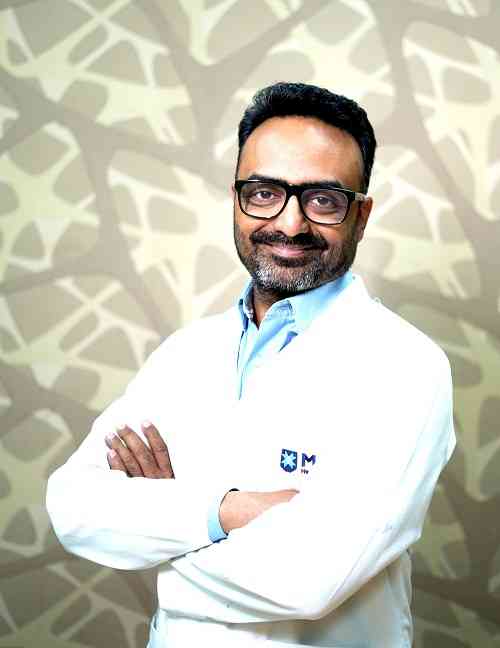Early Detection and Screening Programs for Oral, Head, and Neck Cancer

By Dr. Sangram Keshari Panda, Consultant – Surgical Oncology HCG Panda Cancer Hospital, Cuttack
Our smile is more than just a reflection of joy and happiness; it’s a window to our overall health and well-being. Oral health, involving teeth, gums, and the tongue, plays a major role in our well-being. The head and neck regions are complexly connected, with the oral cavity forming the initial part of the digestive and respiratory tracts. Maintaining good oral health not only prevents dental issues like cavities and gum disease, but it can also contribute to overall physical health by reducing the risk of systemic diseases. Regular dental check-ups and proper oral hygiene habits are essential for promoting well-being throughout the body. Detrimental lifestyles like smoking and extreme alcohol consumption not only damage your teeth and gums but also irritate the delicate tissues of the head and neck, increasing the risk of cancer.
Warning signs and symptoms: Many of us wouldn’t hesitate to visit the doctor for a persistent cough, but what about a sore throat that lingers. Early signs of head and neck cancers can often mimic common disorders. Keep an eye out for:
• Mouth- unexplained sores, white or red patches on the gums or tongue, persistent bleeding, loose teeth, or numbness in the mouth.
• Throat- difficulty in swallowing, a persistent sore throat, hoarseness, or a lump in neck.
• Other- unexplained earaches, changes in your bite and blood in saliva
Taking Charge of your Oral Health
• Limit tobacco use: Smoking, chewing tobacco, and even second-hand smoke are major risk factors.
• Moderate alcohol consumption: Excessive alcohol intake can heighten the risk of cancer.
• Maintain a healthy diet: Include plenty of fruits and vegetables in your nutrition, which are rich in vitamins and antioxidants.
Early Detection Saves Lives: Early detection is a key to effective treatment. Regular dental check-ups are your first line of defence. Self-examinations are also empowering. Get familiar with the healthy look and feel of your mouth and report any constant changes to your dentist.
• Know the major risk factors: Age, tobacco use, extreme alcohol consumption, and HPV infection are some of the key factors.
• Self-examinations at home: Self examine your mouth and neck for lumps, sores, or patches on a regular basis. Early signs are often painless, so vigilance is the key.
• Have dental check-ups regularly: Don’t underestimate the power of your routine dental visit.
• Opportunistic Screening: Many doctors can perform a quick visual exam during regular visits. Talk to your doctor about incorporating an oral screening into your monthly routine.
• Advanced Diagnostics (if needed): If screening raises concerns, further investigation may be needed. Biopsy or imaging tests can provide a definitive diagnosis.
The power of Screening Programs: The successful screening program relies on various key elements-
• A comprehensive visual and physical examination of the mouth and neck, including lymph nodes, forms the cornerstone of screening program.
• The program’s effectiveness hinges on many people getting screened.
• Doctors must ensure accurate assessments.
• Stringent measures ensure reliable test results.
• A smooth path exists for potential cases requiring further tests and examinations.
Beyond Visual Tests: Exploring Advanced Detection Methods
While visual tests are crucial, researchers are exploring additional tools for early detection:
• Non-invasive Diagnostics: Procedures like brush biopsy, cytology tools and special fluorescent lighting aid in examining suspicious abrasions.
• Artificial Intelligence (AI): AI-Powered imagery systems, trained on vast datasets, show promise for improved detection accuracy.
• Liquid Biopsy: This blood test offers a minimally invasive way to detect cancer markers and monitor treatment response.
• Salivary Biomarkers: Examining specific molecules in saliva holds potential for non-invasive cancer diagnosis.
• Salivaomics: This emerging filed explores the full spectrum of molecules in saliva, potentially unlocking a treasure trove of biomarkers.
Remember, prevention is always better than cure. Maintaining good oral hygiene by brushing twice daily, flossing regularly and quitting smoking significantly reduces the risk of oral, head and neck cancers. Schedule regular dental checkups, adopt a healthy lifestyle and be mindful of any unusual changes in your mouth, throat, and neck. By taking these steps, we can all protect our smiles and safeguard our overall health and quality of life. Early detection & early treatment can cure the disease.


 City Air News
City Air News 







